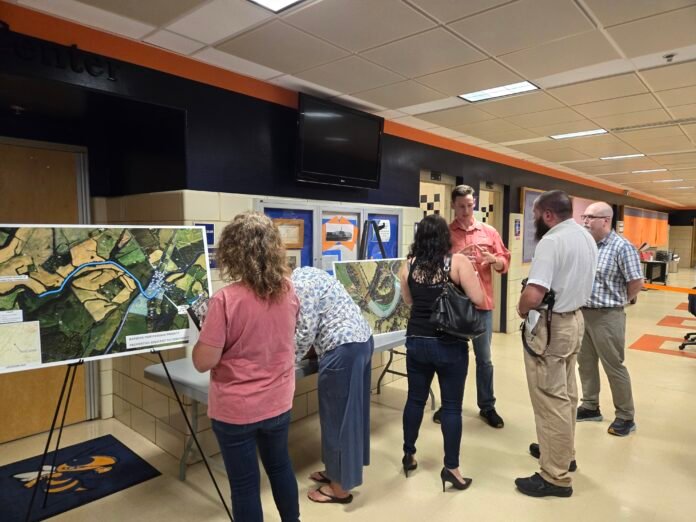A project that would remove all or part of the Rapidan Mill Dam has residents asking questions.
Last week, American Climate Partners (ACP) held a community information meeting regarding the Rapidan Fish Passage Project (RFPP) which aims to “boost the health of the mid-Atlantic anadromous fisheries through the removal of the Rapidan Mill Dam.” The idea is to remove what ACP calls the “last barrier in the Rappahannock River watershed to migratory fish attempting to reach their ancestral spawning grounds near the Blue Ridge Mountains.” The project focuses heavily on American Shad, but includes other native fish as well. American Climate Partners launched the Rapidan Institute in 2020 to focus on comprehensive fisheries and floodplain habitat restoration in the Rapidan and Robinson River Valleys. A consortium of local, state and federal partners as well as other nonprofit organizations are working together to complete the project. Several of those partners were present at the informational meeting to answer questions.
Removing the dam isn’t unique to Rapidan. According to American Rivers, 80 dams were removed nationwide in 2023 and more continue to be removed every year. According to Louise Finger with Virginia Department of Wildlife Resources (DWR), dams make upstream water deeper and slower moving, changing river-like habitat into more uniform lake-like habitat. The deep water drowns what would be shallower river features, causing the surface temperature and evaporation rate to increase, dissolved oxygen to decrease, sediment to settle upstream, scour downstream and disrupts the nutrient cycle thus disrupting the natural habitat native aquatic species depend on. Dams are also physical barriers to aquatic species’ ability to move upstream and can be a site of human drownings.
Adam Shellhammer of American Rivers said there are 500,000 dams nationwide and the AR organizational mission is to remove 30,000 of them. He said there is no quicker way to improve a waterway.
Mike Collins, ACP Executive Director, said removing the dam wasn’t the first objective of the Rapidan Fish Passage Project. He said the first thought was to keep the dam, opting to install a fish-friendly turbine. That didn’t pan out as it couldn’t be installed and the previous hydropower business wasn’t even breaking even.
“I know many of you all do not want this project and hate the fact that we’re trying to do this,” Collins said during last week’s meeting. “You’re upset, pissed and all I can say about that is that our first goal on this was not to alter the dam. It was the worthy conservation goal of being one of the most important conservation projects in the Chesapeake Bay watershed.”
Collins said when it comes to having a successful fish passage project, the organization has three criteria–has to be designed to last in perpetuity and can’t have any maintenance; has to be a bonafide passage for fish that spawn or live in freshwater or saltwater; and has to be a cost that the organization can figure out way to pay for.
Rapidan resident Bruce Hegyi said in November, RFPP was planning to study a fish ladder. The Orange dam, approximately 10 miles upstream, utilizes one. That dam, which is a water supply dam, is very low compared to the taller Rapidan Mill Dam. Alan Weaver of DWR said a fish ladder on the taller dam wouldn’t be possible.
Collins said two options remain for the Rapidan Mill Dam–partial removal or full removal.
Questions arose about the possibility of creating an area for recreational use at the river once the dam is removed. ACP Realty Holdings, Inc, a subsidiary of ACP, owned the Rapidan Mill Dam as well as four acres of riverbank on the Culpeper side of the river. Collins said while that land could be used for public access, if the community doesn’t want that and is resolutely opposed to it, it doesn’t have to be done. He said it’s not fundamental to the fish passage project.
Additionally, Collins said the Rapidan Milling buildings and the dam are failing slowly. He said the entire complex is falling apart and the dam won’t last forever. The downside, he said, to doing nothing is at some point it will fall apart and it can either be removed for fish passage or be repaired through some type of fundraising endeavor, which would be very expensive considering there’s no return on the investment.
The RFPP is being funded through a $7.9 million grant from the National Oceanic and Atmospheric Administration Fisheries. Collins said the grant has not been affected by recent federal cutbacks and is a reimbursement grant. He said should funding be impacted, the project would be slowed down, but is unlikely to be halted.
“The thing about this project is it’s so significant from a conservation standpoint it’s our organization’s belief that there are other private sources we could tap to get the job done,” Collins said.
Currently, a variety of testing is being conducted to determine how the river would be impacted by the dam’s removal. The data will be used to develop models to create the first conceptual design which is due to NOAA in August. The modeling will continue through two additional submittals.
There are plans to host additional informational meetings regarding the project. Those will likely be announced via the RFPP website at https://americanclimatepartners.org/rapidan-institute/.

